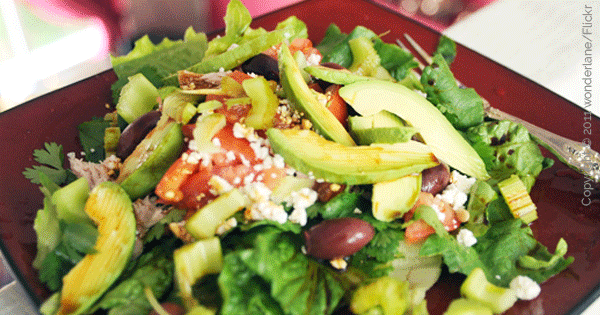Advertisement
Salads are everyone's go-to healthy meal--and why not? Salads are fun, easy, filled with veggies, and low in calories... right?
Not always. Because companies know everyone assumes salads are healthy, they sneak in those extra calories and sweeteners to keep you eating their salad.
For example: did you know a chicken Caesar salad at the Cheesecake Factory is over 1,500 calories, with 16 grams of saturated fat? Yup, that's pretty much your entire day's worth of calories in one sitting. You may as well have half of a Little Caesars cheese pizza instead; it's just 1,120 calories, 380 calories less than the salad.
You might not know this, but you might be accidentally making the same mistakes as the Cheesecake Factory, causing your salad to tip the scale. So how do you ensure your salad remains healthy and nutritious? Check out this list below.
1. Your salad dressing. It's incredibly easy for large amounts of calories to make their way onto your salad through your dressing. That's not to say that you should necessarily avoid full-fat dressings, though. Full-fat dressings actually help you stay fuller, longer, and give your salad the heartiness it needs--you just need to be sure you're picking the right salad dressing, Vinaigrette dressings are always a good bet, but be sure there isn't a ton of added sugar or salt. If you're more into creamy dressings, avoid dressings like Hidden Valley Ranch and instead opt for Annie’s Naturals Organic Buttermilk dressing--same taste, half the calories and fat!
2. Not enough veggies. Without the veggies, there are very few nutrients on your salad plate! According to Cynthia Sass, MPH, RD, contributing editor of Health.com, "One Colorado State University also found that over a two-week period, volunteers who downed a broader array of the exact same amount of produce (18 botanical families instead of 5) experienced significantly less oxidation, a marker for premature aging and disease." That's not all. "Another study, which evaluated more than 450,000 people and looked at their consumption of commonly eaten veggies found that regardless of quantity, the risk of lung cancer decreased when a wider variety of veggies were consumed."
3. Too much or too little protein. "In my clients’ food journals I’ve seen plenty of salads with lots of veggies but no protein, and others with protein overload, like chicken plus cheese and hardboiled eggs," Sass explains. "Protein is an essential salad component for several reasons—it boosts satiety, revs metabolism, and provides the raw materials for maintaining or building lean tissue, including both muscle as well as hormones, healthy hair, skin, and immune cells. But excess protein, beyond what your body needs, can prevent weight loss or lead to weight gain. In short, your body requires a certain amount of protein for maintenance and healing. When too little is delivered those jobs don’t get done."
4. Skipping starch. You need starch in order to avoid burning through all the protein you added to your salad for fuel--which means it doesn't use the protein to repair and build muscle. Sass explains, "I find that for my clients, this starch addition boosts satiety and energy in the hours after eating, but it’s still a small enough portion to allow for weight loss. In fact, when I’ve had clients resist adding carbs and skip this step, they typically seek out more snacks and wind up stalling weight loss. If you’re hesitant, try it and see how your body responds." When most people think of starch, they think of bread--that's not exactly it. For your starch, try adding chilled quinoa, roasted organic corn, or a cubed roasted red potato to your salad!
5. Too little seasoning. Without seasonings, you won't enjoy your salad--meaning it will become a chore to eat, and you won't want to keep eating them. "When I’ve heard people complain about disliking salads it’s typically because they’ve been eating very plain pairings, like romaine with just oil, vinegar, and bland grilled chicken," Sass said. Try adding some yummy flavors to your salad to spice things up (see what I did there?); try tossing fresh herbs into the mix like basil, cilantro or mint; whisk herbs, spices and raw or roasted garlic into oil and vinegar, and add pre-seasoned ingredients, like herbed quinoa, pesto-slathered grilled veggies, or spicy guacamole.
What do you think of this list? Are you guilty of any of these in your salads? Let us know in the comments!
Copyright © 2011 wonderlane/Flickr




